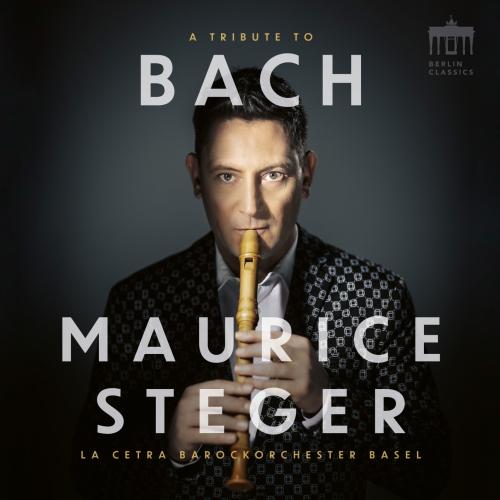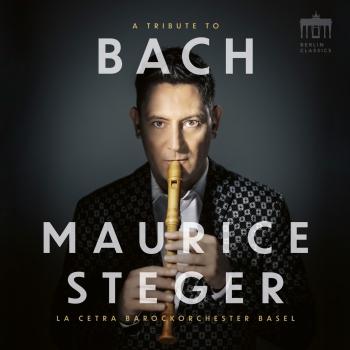
A Tribute to Bach Maurice Steger & La Cetra Barockorchester Basel
Album info
Album-Release:
2023
HRA-Release:
08.09.2023
Label: Berlin Classics
Genre: Classical
Subgenre: Chamber Music
Artist: Maurice Steger & La Cetra Barockorchester Basel
Composer: Johann Sebastian Bach (1685-1750)
Album including Album cover
- Johann Sebastian Bach (1685 - 1750): Concerto in D Major for recorder, strings & b.C., BWV 1053 (Arr. Sebastian Wienand):
- 1 Bach: Concerto in D Major for recorder, strings & b.C., BWV 1053 (Arr. Sebastian Wienand): I. Allegro 07:44
- 2 Bach: Concerto in D Major for recorder, strings & b.C., BWV 1053 (Arr. Sebastian Wienand): II. Siciliano 07:00
- 3 Bach: Concerto in D Major for recorder, strings & b.C., BWV 1053 (Arr. Sebastian Wienand): III. Allegro 06:08
- Ricercar in C Minor À 6 (From the Musical Offering):
- 4 Bach: Ricercar in C Minor À 6 (From the Musical Offering) 07:17
- Sonata G Minor for Recorder and Obbligato Harpsichord, BWV 1020:
- 5 Bach: Sonata G Minor for Recorder and Obbligato Harpsichord, BWV 1020: I. Allegro 04:14
- 6 Bach: Sonata G Minor for Recorder and Obbligato Harpsichord, BWV 1020: II. Adagio 03:02
- 7 Bach: Sonata G Minor for Recorder and Obbligato Harpsichord, BWV 1020: III. Allegro 03:30
- Triosonata in D Minor for Recorder, Violin & B.C., BWV 527:
- 8 Bach: Triosonata in D Minor for Recorder, Violin & B.C., BWV 527: I. Andante 04:29
- 9 Bach: Triosonata in D Minor for Recorder, Violin & B.C., BWV 527: II. Adagio E Dolce 03:47
- 10 Bach: Triosonata in D Minor for Recorder, Violin & B.C., BWV 527: III. Vivace 03:13
- Sonata in E Major for Recorder & B.C., BWV 1035:
- 11 Bach: Sonata in E Major for Recorder & B.C., BWV 1035: I. Adagio Ma Non Tanto 02:42
- 12 Bach: Sonata in E Major for Recorder & B.C., BWV 1035: II. Allegro 02:55
- 13 Bach: Sonata in E Major for Recorder & B.C., BWV 1035: III. Siciliano 03:55
- 14 Bach: Sonata in E Major for Recorder & B.C., BWV 1035: IV. Allegro Assai 02:50
- Concerto in F Major for Harpsichord, Two Recorders, Strings & B.C., BWV 1057:
- 15 Bach: Concerto in F Major for Harpsichord, Two Recorders, Strings & B.C., BWV 1057: I. Allegro 06:19
- 16 Bach: Concerto in F Major for Harpsichord, Two Recorders, Strings & B.C., BWV 1057: II. Andante 03:47
- 17 Bach: Concerto in F Major for Harpsichord, Two Recorders, Strings & B.C., BWV 1057: III. Allegro Assai 04:17
Info for A Tribute to Bach
This album already carries the intention in its title: "A Tribute to Bach" is meant to be a deep bow by the world-renowned recorder player Maurice Steger to the great master of the music world, Johann Sebastian Bach.
For his Bach project, Maurice Steger has chosen six compositions that follow six different musical genres and placed the recorder at the forefront of solo instrumentation. In doing so, he places himself in the tradition of Bach himself, who has been proven to have repeatedly undertaken new instrumentations for his works in the course of his life. The result in terms of sound is fascinating: Bach becomes a convincing recorder player through Maurice Steger's interpretation.
First up is the Concerto in D major for recorder, strings & b.c., BWV 1053 R. He is accompanied here by the multi-award-winning La Cetra Barockorchester Basel, with whom he already collaborated on his last album. The orchestra fulfils all wishes that could be placed on a baroque orchestra and consists exclusively of specialists for early music. The following excerpt from the cycle "Das musicalische Opfer" (BWV 1079), the Sonata in G minor (BWV 1020), the Trio Sonata in D minor (BWV 527), and the Sonata in E major (BWV 1035) feature soloists from the La Cetra Baroque Orchestra. Among others, violinist Katharina Heutjer, harpsichordist Sebastian Wienand, cellist Jonathan Peśek and recorder and bassoonist Claudius Kamp should be mentioned here.
At the end, the full richness of the fantastic orchestra is heard again in the Concerto in F major for harpsichord, two recorders, strings & b.c., (BWV 1057). These works span several important stages of Johann Sebastian Bach's life and were written in the span between 1721 and 1747. Some of them were written in Köthen, and one of the works, the Sonata in E major, was demonstrably composed on a trip to Berlin. Later, in Leipzig, Bach reworked or completed many of his works. In the case of the G minor Sonata, the authorship could also lie with his son C.P.E. Bach, but experts are not entirely sure. Bach created the works for special occasions and clients, or for friends and highly talented musicians of his time.
It is indeed known that Bach himself also played the recorder, especially in his youth. Even then, the recorder was the "beginner's instrument" with which one could easily learn basic musical skills such as note reading, rhythm and intonation. It is true that Bach used the recorder with great refinement in many works, but unfortunately there are no records of his pure recorder works. We therefore cannot say with certainty how his music would sound for recorder, but as we know, his music leaves much room for interpretation and experimentation. Bach's notations are often very detailed and contain specific instructions, but his music is so profound and complex that there are different ways to interpret and express it.
The music on this album changes from mad instrumental virtuosity to very gentle forms of expression, as only a true master of the recorder can gallantly sound. A recorder player like Maurice Steger cannot bow more beautifully and gracefully to Johann Sebastian Bach.
Maurice Steger, recorder & direction
Sebastian Wienand, harpsichord
La Cetra Barockorchester Basel
Maurice Steger
is one of the most fascinating recorder players, conductors and musical professors working in the sphere of Early music. With his vibrant manner, intense and full instrumental sound and amazing technique, this "recorder wizard" has managed to bring to prominence the recorder as an instrument in all its fascinating forms. In 2015 he received the 2015 ECHO Classic Award as "Instrumentalist of the Year".
As a soloist, conductor or both at once, he regularly performs with the top period instrument ensembles, such as the Akademie für Alte Musik Berlin, but also with leading modern orchestras such as the Zurich Chamber Orchestra. With fellow musicians and friends such as Hille Perl, Marco Postinghelm and Xenia Löffler, he dedicates himself to a continuously updated repertoire of Early music. He also performs with artist colleagues such as Cecilia Bartoli, Andreas Scholl and Nuria Rial. Along with early music, Maurice Steger also engages with new concert formats and contemporary compositions. Tours of Asia and Australia have led to performances with the Australian Brandenburg Orchestra and the Malaysia Philharmonic Orchestra among others. He was the first recorder player from the West to perform with the Traditional Taipei Chinese Orchestra. He also regularly performs in North and South America.
His commitment to musical education is also extremely important to him: in order to encourage young children to playfully engage with classical music, he invented the character of "Tino Flautino", and has performed hundreds of children's concerts in this role. Maurice Steger also gives various master classes each year, and in 2013 took over the directorship of the Gstaad Baroque Academy.
This album contains no booklet.










